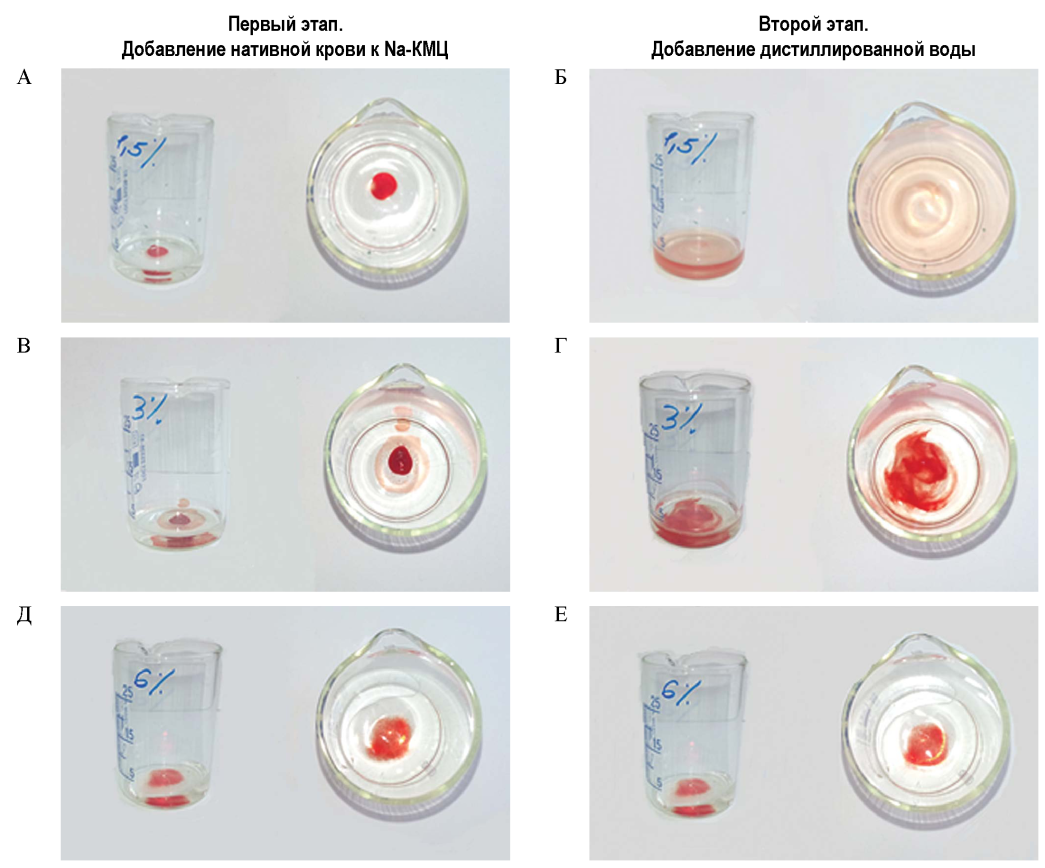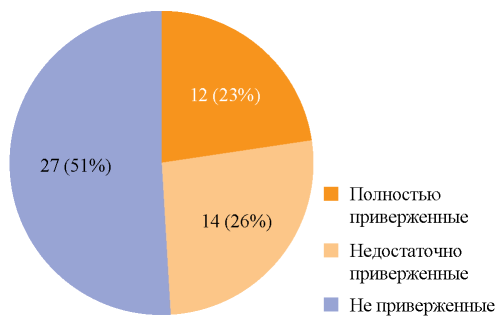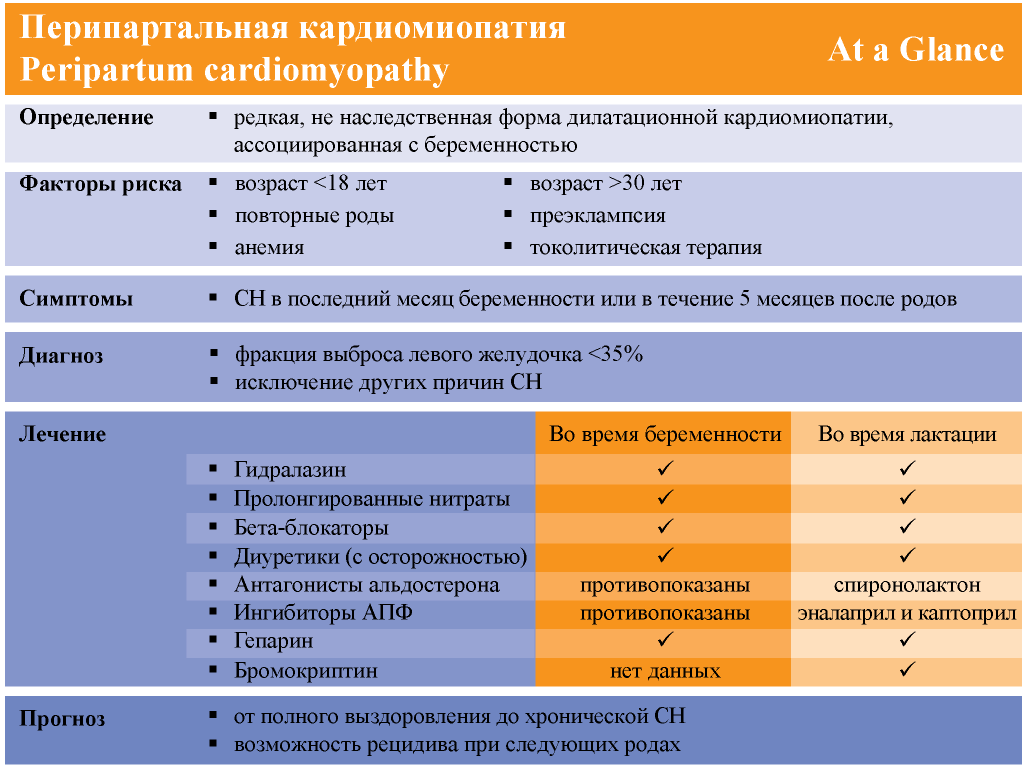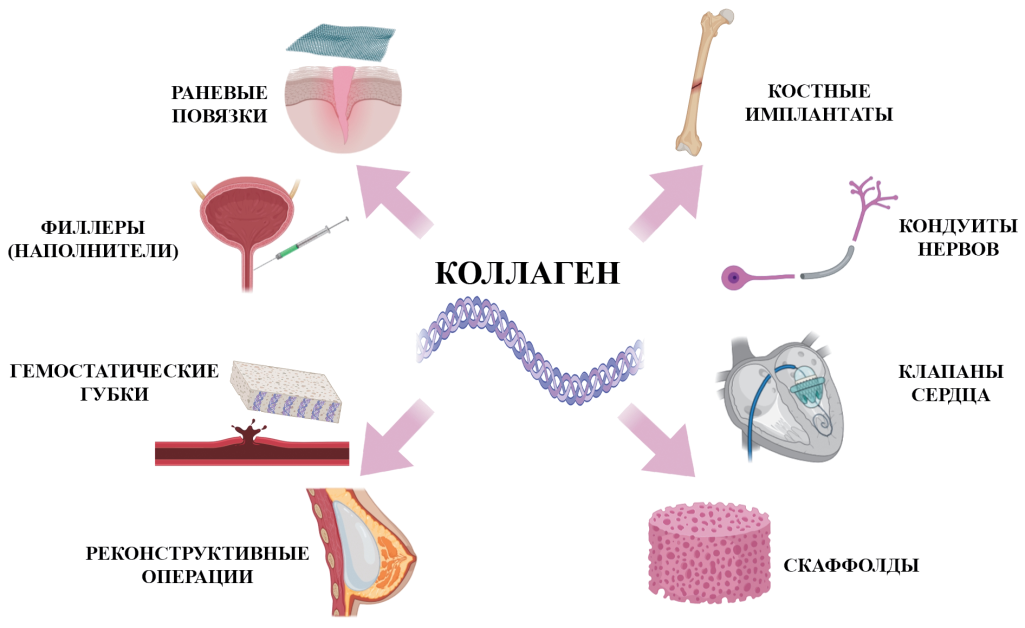PATHOLOGICAL PHYSIOLOGY
Liver surgeries are associated with the risk of bleeding and the development of adhesive disease. Sodium carboxymethylcellulose (Na-CMC) forms an elastic swelling gel and a “lattice” that holds the blood cells.
The aim: determine the concentration of Na-CMC, which has the maximum hemostatic and anti-adhesive effect, during liver surgeries in the experiment.
Materials and methods. The coagulating effect of Na-CMC (from 0.5% to 9%) was studied in vitro. In vivo experiment on 167 male Wistar rats weighing 185–250 g studied the bleeding time and the amount of blood loss, anti-adhesive activity in the model of liver surgery by cutting off the edge of the organ in the standard way: the depth and width of the wound is 1 cm; the height is 3 mm.
Results. In vitro the minimum coagulating effect was obtained in 3% of Na-CMC. In vivo the maximum effect on reducing the bleeding time (–46% compared to the control, p < 0.01) and the amount of blood loss (–27% compared to the control, p < 0.01) had 6% Na-CMC. Then, according to the degree of decrease in the bleeding time, there were: 5% Na-CMC (–40%), 4% Na-CMC (–37%), 3% Na-CMC (–29%), 7% Na-CMC (–27%), 8% Na-CMC (–11%). For the amount of blood loss, a similar pattern of decreasing effect was observed: 5% Na-CMC (–21%), 4% Na-CMC (–14%), 7% Na-CMC (–12%), 3% Na-CMC (–11%), 8% Na-CMC (–5%). When comparing all the studied concentrations of Na-CMC gel with the control group in terms of bleeding time and blood loss, the differences are statistically significant: p < 0.01. Maximum anti-adhesive activity was observed for 6% Na-CMC on days 7 and 14 after surgery: the adhesive process was estimated at 0.497 [0.000–0.497] and 0.962 [0.000–1.301] points vs. 2.457 [2.118–2.457] and 4.071 [3.758–4.602] points in the control group (p < 0.01).
Conclusion. The maximum hemostatic and anti-adhesive effect has 6% Na-CMC.
N-methyl-D-aspartate (NMDA) receptors belong to the group of inotropic glutamate receptors, which are found in rat cardiomyocytes.
Aim. To evaluate the influence of a non-competitive antagonist of NMDA-receptors — МК-801, separately or in combination with glutamate and/or glycine, on cardiodynamic parameters, coronary flow and oxidative stress biomarkers in isolated rat heart.
Materials and methods. 40 Wistar albino rats were divided into 4 groups (10 rats per group). Aorta of isolated rat heart was cannulated and perfused retrogradely by Krebs-Henseleit buffer in the Langendorf mode. Group 1 received МК-801 (50 µmol/l), group 2 received МК-801 and glycine (100 µmol/l), group 3 received МК-801 and glutamate (100 µmol/l) and group 4 received МК-801, glutamate and glycine. Parameters of cardiac dynamics and coronary blood flow were registered during the last minute of tested substance infusion (E) and at the point when artery perfusate samples were taken at the end of the control period (C). The difference between two points (C and E) was calculated and expressed in percent with a standard deviation.
Results. Group 1 demonstrated the most prominent decrease of peak left ventricle (LV) pressure increase velocity (–47.59 ± 5.65)%, systolic and diastolic LV pressure: (–45.18 ± 4.87)% and (–37.24 ± 5.15)%, respectively and cardiac rate: (–28.63 ± 3.00)%. The most significant decrease of minimal LV pressure increase velocity was observed in group 2: (–47.43 ± 5.68)%, decrease of coronary blood flow — in group 3: (–23.02 ± 2.49)%. The most significant decline of oxidative stress biomarkers — nitrite and hydrogen peroxide — was observed in group 3: (–29.24 ± 2,70)% and (–23.43 ± 3.15)%, respectively; of superoxide anion radical (O2–) — in group 2: (–55.72 ± 6.90)%, of lipid peroxidation index — in group 1: (–35.77 ± 4.49)%.
Conclusion. Administration of МК-801 results in a statistically significant decrease of cardiac dynamic parameters and lipid peroxidation index, compared to MK-801 in combination with glutamate and/or glycine.
INTERNAL MEDICINE
Direct-acting antivirals (DAAs) therapy is associated with fibrosis regression in patients with hepatitis C virus liver cirrhosis.
Aim. To study the dynamic of liver fibrosis in cirrhotic patients with a DAAs-induced sustained virological response (SVR).
Materials and methods. The retrospective cohort study included 80 cirrhotic patients (male — 43%, median age 54 years). Liver stiffness (LS) was measured by transient elastography before treatment and after SVR. Patients with LS improvement ≥30% were included in group 1, other patients — in group 2. Clinical, laboratory and instrumental parameters were assessed. Independent risk factors for the absence of LS improvement ≥30% were determined by binary logistic regression with the definition of odds ration (OR) and 95% confidence interval (CI).
Results. LS reduced from 21.35 (15.2; 27.7) to 13.5 [10.1; 20.0] kPa (p < 0.001), the median reduction was 5.1 [2.6; 11.0] kPa. Regression of fibrosis from F4 to F2 and F3 stages was observed in 16 (20%) and 19 (24%) of cases, respectively. Overall, 36 patients were included in group 1, 44 patients — in group 2. Platelet counts increased in group 1 compared to group 2 by 24.5% vs 5.2% (p = 0.014), a disappearance or reducing the size of esophageal varices were observed in 72% vs. 35% of cases (p = 0.035). Significant differences in ALT, AST, albumin, prothrombin time dynamics were not observed. Baseline albumin level ≤35 g/l is an independent risk factor for the absence of significant improvement of LS: OR 6.7 (95% CI 1.7–25.9, p = 0.006).
Conclusion. SVR leads to fibrosis regression to F2-F3 stages in 44% of patients. Baseline albumin level ≤35 g/l is an independent risk factor for the absence of significant improvement of LS.
Despite the proven efficacy of lipid-lowering therapy, adherence to long-term statin therapy in patients with cardiovascular disease remains low.
Aim. To study adherence to long-term statin therapy and factors associated with adherence in patients with high and very high cardiovascular risk (CVR) in real clinical practice.
Materials and methods. The single-center cohort study included 53 patients (mean age 68.1 ± 10.2 years) with high or very high CVR on the SCORE scale and have been taking statins for at least 3 months prior to inclusion in the study. The level of low-density lipoprotein cholesterol (LDL-C), cognitive impairment (MoCA test), anxiety and depression (HADS scale), presence of senile asthenia (FRAIL scale), M. Charlson comorbidity index were assessed. Adherence to statin therapy was assessed using the original questionnaire. The correlation between patient adherence and ordinal variables for the scores of the studied scales was studied.
Results. Completely adherent to statin therapy were only 12 (22%) patients, 14 (26%) were insufficiently adherent, 27 (51%) were non-adherent. The target level of LDL-С was achieved in 13 (25%) patients. 38 (72%) patients showed a decrease in cognitive functions; a positive correlation was found between adherence and the MoCA test (r = 0.44, p = 0.04). Clinical and subclinical depression and anxiety were noted in 12 (23%) and 14 (26%) patients, respectively. A statistically significant negative correlation was found between adherence and depression (r = –0.32; p = 0.04) and a positive correlation between adherence and anxiety (r = 0.44; p = 0.04). There was no statistically significant correlation between adherence and the FRAIL fragility scale, as well as the M. Charlson comorbidity index.
Conclusions. Depression and cognitive decline are associated with decreased adherence to statin therapy.
The association between depressive disorder and quality of life of middle-aged patients with cerebral microangiopathy has not been fully investigated.
Aim. Study the association between the depression level and quality of life (QOL) in patients with cerebral microangiopathy.
Materials and methods. In outpatients 45–59 years old (n = 262, 42% men, 58% women) with cerebral microangiopathy and depression, the level of anxiety was assessed using the HADS-A scale, QOL — using the SF-36 questionnaire. According to the severity of depression (HADS-D subscale), the following were distinguished: group 1 (n = 116) — 8–10 points (subclinical) and group 2 (n = 146) — ≥11 points (clinical). To analyze the data used: t-test, correlation coefficient, logistic regression model; odds ratio (OR) and 95% confidence interval (CI).
Results. In group 2, the average anxiety score on the HADS-A scale was 14.3 ± 4.6 points, and for anhedonia was – 10.4 ± 4.2 points, which is statistically significantly higher than in group 1: 10.1 ± 4.2 and 7.1 ± 2.6 points, respectively (p < 0.05). The overall QOL score was statistically significantly lower in group 2: according to the physical component of health, 52.4 ± 26.5 vs. 88.8 ± 43.5 in group 1 (p < 0.05) and psychological component 38.5 ± 19.4 vs. 70.8 ± 35.8 in group 1 (p < 0.05). Depression, anxiety and anhedonia are associated with a negative effect on the overall QOL: r = −0.84 (p < 0.05), r = −0.81 (p < 0.05), r = −0.87 (p < 0.05), respectively. This association does not depend on age, obesity, type 2 diabetes mellitus: OR for depression was 2.1; 95% CI (1.8–2.4), p < 0.05; anxiety — 1.9; 95% CI (1.2–2.2), p < 0.05; anhedonia — 2.3; 95% CI (2.1–2.7), p < 0.05, respectively.
Conclusion. Clinically significant depression reduces noticeably QOL. An increase in the severity of affective symptoms leads to a deterioration in both the psychological and physical components of QOL. Decreased QOL does not depend on age, obesity, type 2 diabetes mellitus.
Introduction. Peripartum cardiomyopathy (PPKMP) is a rare cause of heart failure (CHF) in healthy women during pregnancy and within 5 months after delivery.
Case report. A 33-year-old female patient, a native of Tajikistan, first developed shortness of breath and edema of the lower extremities at the 35th week of her third pregnancy. Cesarean section was performed at 39 weeks. Symptoms progressed within 3 months of the postpartum period, hepatomegaly, ascites and hydrothorax appeared. Echocardiography revealed heart chambers dilation, reduced left ventricular ejection fraction (26%), diffuse hypokinesis. The diagnosis of PPCM was established. Perindopril, bisoprolol, spironolactone, furosemide, bromocriptine, heparin were prescribed. The severity of HF symptoms decreased significantly during 12 days of treatment.
Discussion. PPCM is a diagnosis of exclusion. Myocarditis, dilated and ischemic cardiomyopathy were considered in the differential diagnosis. The factors associated with increased risk of PPCM were age over 30 years, multiparity, preeclampsia. The clinical effect of bromocriptine confirms the diagnosis.
SURGERY
ISSN 2658-3348 (Online)











































